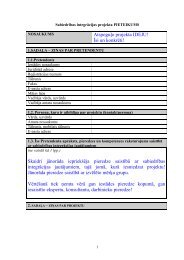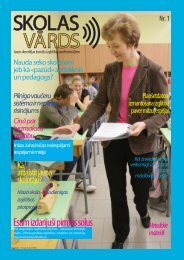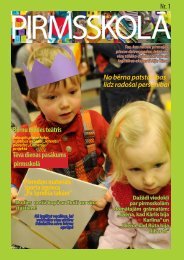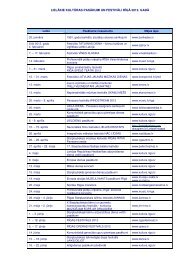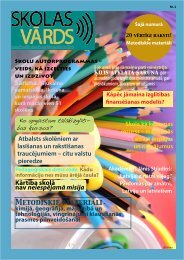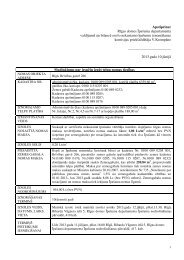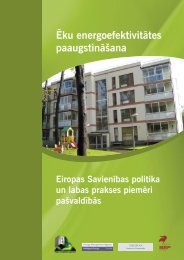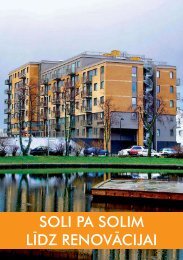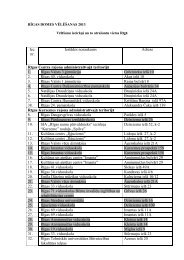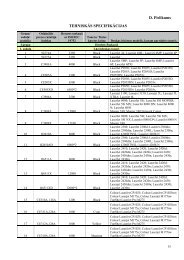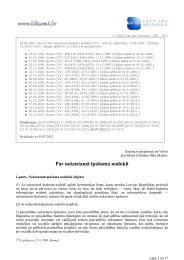Riga - European Capital of Culture 2014 candidate
Riga - European Capital of Culture 2014 candidate
Riga - European Capital of Culture 2014 candidate
- No tags were found...
You also want an ePaper? Increase the reach of your titles
YUMPU automatically turns print PDFs into web optimized ePapers that Google loves.
mobile centre in riga’sneighbourhoodsTaking the concept that ‘the centre iswhere we are’, the project envisagesactivities in the centres <strong>of</strong> outlying localities,creating spaces that will serveas a platform for positive communication,cultural events and the strengthening<strong>of</strong> local identities.The goal <strong>of</strong> the project is to build localawareness in different neighbourhoods,developing smaller local centres to deepenthe residents’ sense <strong>of</strong> belonging to theneighbourhood and thereby enhance theirsense <strong>of</strong> responsibility as citizens <strong>of</strong> thecity. Reaching this goal also requires a focuson the local architecture and developmentthat fosters a sense <strong>of</strong> place.This project consists <strong>of</strong> two parts: theoreticalstudy, and practical implementation– reclamation <strong>of</strong> existing urban environmentsand the construction <strong>of</strong> newinstallations, objects and pavilions in thereclaimed space.The project will be based on an analysis<strong>of</strong> city planning in <strong>Riga</strong> neighbourhoodsand the prospective development <strong>of</strong> newcentres. Selecting approximately 3–5 different<strong>Riga</strong> neighbourhoods, brief portraitsencapsulating the social, geographical,historical, cultural, architectural and spatialcharacter <strong>of</strong> the individual neighbourhoodswill attempt to define the identity <strong>of</strong>the urban environments. The studies will investigatea variety <strong>of</strong> factors like the neighbourhoods’specific architectural histories,notable persons hailing from the area,the people who live in the neighbourhoodnow and those who lived there in the past,and local traditions. Residents will beasked to reveal their perceptions <strong>of</strong> theneighbourhood and what they most <strong>of</strong>tenassociate with it, spatially – the buildings,squares or parks that symbolize it – in aneffort to capture the spirit <strong>of</strong> place.The studies will compile the essential informationon the character and identity <strong>of</strong>each locality, including proposals for therelevant local government bodies and arearesidents’ recommendations to ensure sothat the identity <strong>of</strong> the locality is respectedand supplemented, rather than sweptaway in the course <strong>of</strong> development.Based on the results <strong>of</strong> the studies, concreteplans will be made for selected sites– pavilions will be built, existing spaces (forexample cultural and/or sports centres) willbe adapted for temporary use in the projector transformed, and public space such assquares, parks and promenades will be improvedand utilised as sites for installations.The project aims to promote the city’sdevelopment and new architecture, helping<strong>Riga</strong> become more urban by contrastto the suburbanism <strong>of</strong> the Sovietera. Encouraging development, strongerneighbourhood identities, the transformation<strong>of</strong> specific localities, and inspiring residentsto positive change requires small,positive impulses. A spatial and institutionalframework for this sort <strong>of</strong> dialoguemust be created. Spatial intervention withthe necessary stimulus, whether temporarystructures (pavilions, installations) orthe transformation <strong>of</strong> existing structuresthrough ephemeral installations, will shiftthe local centres <strong>of</strong> gravity to change theresidents’ habitual daily routine, becomingepicentres <strong>of</strong> fresh urban scene.Such new and renewed places and spaceswould become new urban centres – gatheringspots and venues for discussion for theneighbourhoods’ residents. The pavilionsand the newly created spaces would first<strong>of</strong> all be meeting-places where residents<strong>of</strong> the immediate neighbourhood couldcome up with and carry out their own initiatives,such as preparing meals together,playing chess, and exchanging views ininterest groups. Since these spaces wouldalso be venues for urban games, seminarsorganised by NGOs and the City Council,conferences, lectures, dances, contemporarytheatre and films, they can serve asmagnets for mutual understanding and facilitateintercultural integration, welcomingboth <strong>Riga</strong> residents and visitors.What: Research <strong>of</strong> <strong>Riga</strong>’s urbanenvironments and use <strong>of</strong> the resultingstudy to implement ideas found therein indifferent neighbourhoods.Where: <strong>Riga</strong>’s neighbourhoods.When: Research conducted and compiled:2010–2012.riga’s key to fellowshipEvery city is surprisingly interesting inthe diversity <strong>of</strong> its culture. The “MobileCentre” will also travel to <strong>Riga</strong>’s sistercities in Europe and around theworld. One <strong>of</strong> the primary symbols <strong>of</strong><strong>Riga</strong>, used in its seal, is the key to thecity. <strong>Riga</strong>’s ‘diplomatic relations’ in<strong>2014</strong> will also be symbolised by a key“<strong>Riga</strong>’s Key to Fellowship”.Many <strong>Riga</strong> residents probably don’t evenknow that <strong>Riga</strong> has 29 ‘sister cities’ –Aalborg (Denmark), Almaty (Kazakhstan),Amsterdam (The Netherlands), Astana(Kazakhstan), Bordeaux (France), Bremen(Germany), Dallas (USA), Florence (Italy),Calais (France), Cairns (Australia), Kyiv(Ukraine), Kobe (Japan), Moscow (Russia),Minsk (Belarus), Norrköping (Sweden),Beijing (China), Pori (Finland), Rostock(Germany), St. Petersburg (Russia),Santiago (Chile), Stockholm (Sweden),Suzhou (China), Taipei (Taiwan), TallinnProject development: 2013.Project implementation and exhibitions: <strong>2014</strong>.Concept authors: Oskars Redbergs, ArtisZvirgzdiņš, Zanda Redberga(The Foundation for InterdisciplinaryCooperation “mT15”, www.mt15.lv), unIlze Martinsone (Latvian Museum <strong>of</strong>Architecture, www.archmuseum.lv).Project development: Architectural anddesign firms.Organisers: <strong>Riga</strong> City Council, Foundationfor Interdisciplinary Cooperation “mT15”Project implementation: Workshops,construction firms, Latvian Museum <strong>of</strong>ArchitecturePartners: In the research phase – theFoundation for Interdisciplinary Cooperation“mT15”, students <strong>of</strong> city planning at Latvianand foreign universities.(Estonia), Tartu (Estonia), Tashkent(Uzbekistan), Tbilisi (Georgia), Warsaw(Poland), and Vilnius (Lithuania).The goal <strong>of</strong> “<strong>Riga</strong>’s Key to Fellowship” isto involve representatives from <strong>Riga</strong>’s ‘sistercities’ in a collective campaign, makingthe invitation a special one. In addition todrawing the attention <strong>of</strong> <strong>Riga</strong>’s ‘sister cities’to the events in the Latvian capital, thecampaign would show <strong>Riga</strong>’s residents thecultural diversity <strong>of</strong> their ‘sister cities’.All <strong>of</strong> the ‘sister cities’ will be invited to participatein an artistic project to create a keyto fellowship, simultaneously telling thestory <strong>of</strong> cooperation between their citiesand <strong>Riga</strong>. The keys will be exhibited at ajoint exhibition with presentations to showcasethe cultural diversity <strong>of</strong> each participatingcity.What: Exhibition.Where: City Hall.When: June.Concept author: Mārcis GulbisPartners: <strong>Riga</strong> City Council, Department<strong>of</strong> <strong>Culture</strong>, <strong>Riga</strong> City Council ForeignRelations Department.138 139



